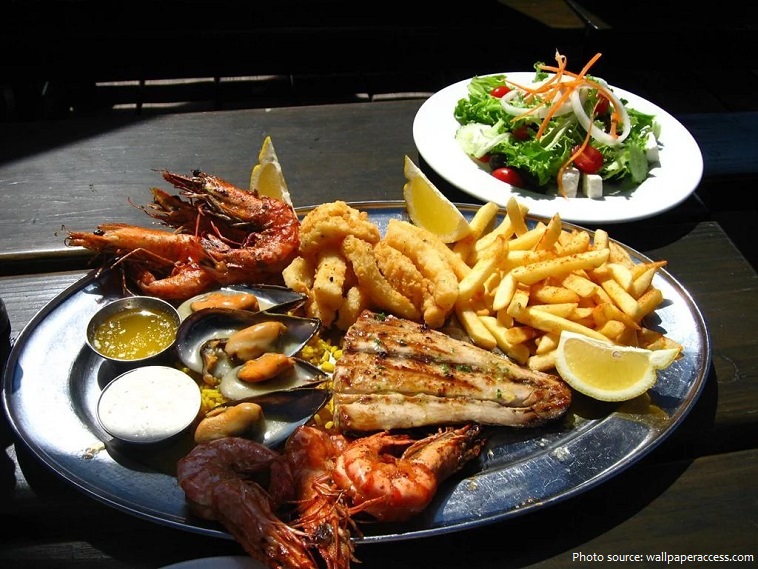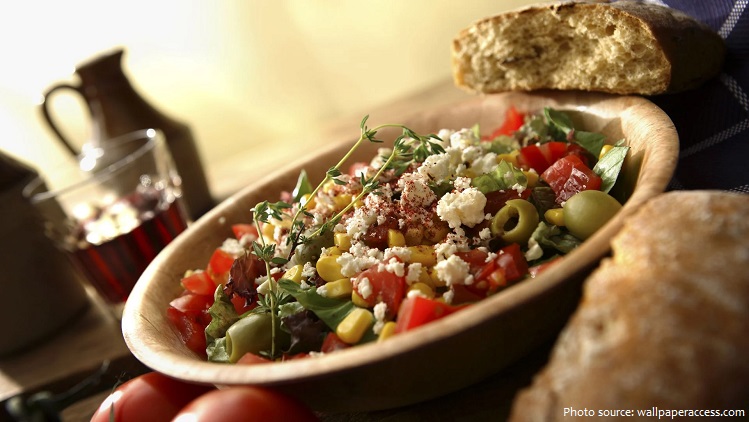
Greek cuisine is a style of cooking derived from the nation of Greece.‚
The most characteristic and ancient element of Greek cuisine is olive oil, which is used in most dishes. It is produced from the olive trees prominent throughout the region, and adds to the distinctive taste of Greek food. The olives themselves are also widely eaten.
The basic grain in Greece is wheat, though barley is also grown. Important vegetables include tomato, aubergine (eggplant), potato, green beans, okra, green peppers (capsicum), and onions.
Honey in Greece is mainly honey from the nectar of fruit trees and citrus trees: lemon, orange, bigarade (bitter orange) trees, thyme honey, and pine honey. Mastic (aromatic, ivory-coloured resin) is grown on the Aegean island of Chios.

Greek cuisine uses some flavorings more often than other Mediterranean cuisines do, namely oregano, mint, garlic, onion, dill, cummin, coriander, and bay laurel leaves. Other common herbs and spices include basil, thyme and fennel seed. Parsley is also used as a garnish on some dishes.
Greeks love cheese! Most people outside of Greece know about Feta, but there is actually a nice array of cheeses used in Greek cuisine. These include: Kasseri, Kefalotyri, Graviera, Anthotyros, Manouri, Metsovone and Mizithra.
Greek cuisine is part of the culture of Greece and is recorded in images and texts from ancient times. Its influence spread to ancient Rome and then throughout Europe and beyond.
Ancient Greek cuisine was characterized by its frugality and was founded on the “Mediterranean triad”: wheat, olive oil, and wine, with meat being rarely eaten and fish being more common. This trend in Greek diet continued in Cyprus and changed only fairly recently when technological progress has made meat more available. Wine and olive oil have always been a central part of it and the spread of grapes and olive trees in the Mediterranean and further afield is correlated with Greek colonization.

In 350 BC, when Alexander the Great extended the Greek Empire’s reach from Europe to India, certain northern and eastern influences were absorbed into the Greek cuisine.
The first cookbook was written by the Greek food gourmet, Archestratos, in 330 BC, which suggests that cooking has always been of importance and significance in Greek society.
In 146 BC, Greece fell to the Romans which resulted in a blending of a Roman influence into Greek cooking.
In 330 AD, Emperor Constantine moved the capital of the Roman Empire to Constantinople, founding the Byzantine Empire which, in turn, fell to the Turks in 1453 and remained part of the Ottoman Empire for nearly 400 years.
Many Greek dishes are inherited from Ottoman cuisine, which combined influences from Persian, Levantine-Arabic, Turkish and Byzantine cuisines: phyllo, tzatziki, yuvarlakia, eggplant papoutsaki, boureki, meze, dolma, hummus, pita bread, papoutsakia, baklava, kadaifi, halva, loukoumi, and more.

In the 20th century, French cuisine had a major influence on Greek cooking, largely due to the French-trained chef Nikolaos Tselementes, who, for example, created the modern Greek pastitsio, such as moussaka by combining the pre-existing eggplant dish with a French-style gratin topping.
Modern chefs owe the tradition of their tall, white chef’s hat to the Greeks. In the middle ages, monastic brothers who prepared food in the Greek Orthodox monasteries wore tall white hats to distinguish them in their work from the regular monks, who wore large black hats.
To a large degree, vegetarian cuisine can be traced to foods and recipes which originated in Greece.
The Greeks are thought to have made red as well as rosé and white wines. Like today, these varied in quality from common table wine to valuable vintages. It was generally considered that the best wines came from Thásos, Lesbos and Chios.

Greek food has a reputation for being heart healthy. This is because it uses olive oil, fish, lean meats, vegetables, herbs and grain. One example is the classic moussaka – a hearty dish made of layers of lamb and eggplant, smothered in béchamel sauce and cheese.
Dining out is common in Greece. The taverna and estiatorio are widespread, serving home cooking at affordable prices to both locals and tourists. Locals still largely eat Greek cuisine.
Common street foods include souvlaki, gyros, various pitas and roast corn.
Fast food became popular in the 1970s, some chains, such as Goody’s and McDonald’s serving international food like hamburgers, and others serving Greek foods such as souvlaki, gyros, tyropita, and spanakopita.
Gyro is probably the most often mispronounced food name. Even its fans usually do not get the pronounced correctly – whether it is mispronounced as “jee-rohs,” “jai-rohs,” “gee-rohs,” The correct Greek pronunciation is “yee-rohs.” The varied names have geographical origins from different peoples’ languages.